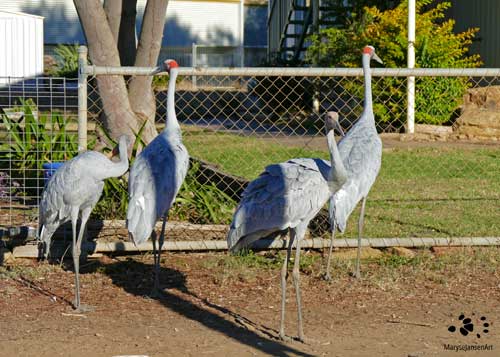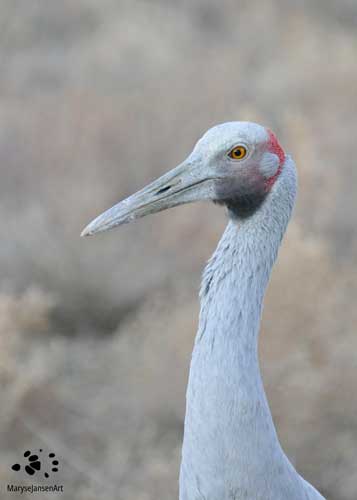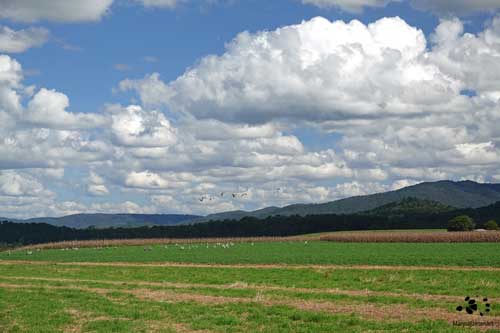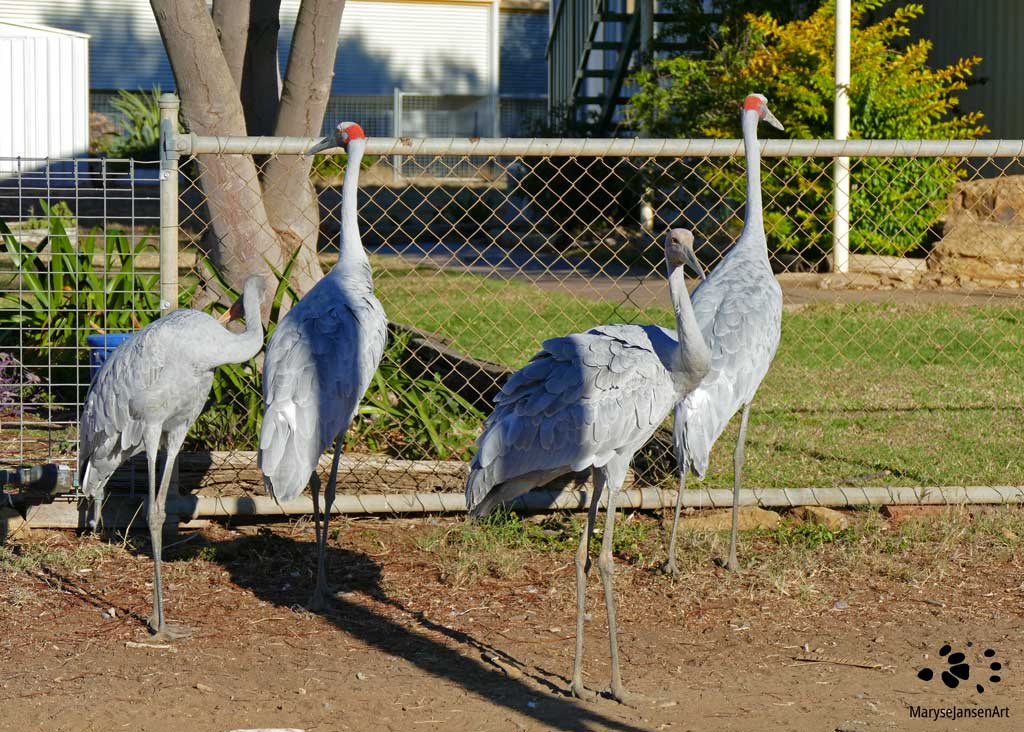Bird Photography with marysejansenart
And many more Brolgas in their natural habitats: wetlands and grasslands

Table of Contents
Brolgas at the Bus Stop!
I will never forget this! The first time I encounter Brolgas up close is at the bus stop!!!! Definitely not what I would have expected from these tall, graceful waterbirds that prefer to spend their time in large, open wetlands – away from people!
I’m in outback town Longreach. It’s winter, which I believe in the early morning when it’s absolutely freezing cold and I can’t find enough layers to wear as I try to make a cup of tea on the campsite. But a good two hours later, it has warmed up to another hot and dusty day and most of my clothes are packed up in the car again. As I’m driving through town I have to blink my eyes to make sure that what I see is real: four beautiful Brolgas, hanging out at the bus stop!
I pull over and take some photos with the window down as I don’t want to hop out and scare them away. It is an astonishing sight! Later, the image is received well on Fine Art America and ties for 2nd place in the FAA contest ‘BIG BIRDS IN AUSTRALIA’ in December 2021. As amazing as this encounter was, I am relieved when I see more Brolgas, but this time in their natural habitat, during my trip in the outback!
Brolgas are graceful crane birds
The Brolga is one of two Australian Crane species and looks very similar to the Sarus Crane. Both birds are predominantly grey in colour. The Brolga can be distinguished by the red colouring, which is confined to its featherless head. In the Sarus Crane the red colour extends down the neck as well. Furthermore the Brolga has a heavier dewlap, which is black. The bird has grey legs, a grey beak and orange eyes. The Brolga is more widespread as well, covering almost half of Australia (the northern and eastern parts), the Sarus Crane is confined to areas in the far north only.

Brolgas are large birds, standing more then 1 metre tall and having a wing span of up to 2.5 metres! Males are a bit taller then females, but otherwise both sexes look the same. With their strong, straight bill, they tear up the dirt in search of tubers – their favourite food. They also feed on certain grains and seeds, shoots and leaves of wetland and upland plants, insects, molluscs and other small animals. Brolgas have the capacity to drink from salt water in the salt water marshes because they have special glands near their eyes through which they can excrete the salt! What an amazing adaptation!
During another trip through rural Queensland, I spot a large flock of Brolgas in the fields. I count about 60 birds! They are obviously feeding and occasionally a small groups takes to the air to land a few hundred metres further where they continue their foraging. After a somewhat difficult take off, which involves lots of wing flapping, their flight is very graceful and a sight to behold! I am delighted with the resulting photo, where these birds add compelling interest to an already lovely landscape image of green fields, rolling hills and a blue sky with interesting cloud formations. To do this image fully justice you would have to see it on a large print!
Check out more Brolgas in the landscape here.

Brolgas mate for life and dance!
Large flocks like these are mainly seen during the non-breeding season. Breeding season is largely determined by rainfall, therefore almost at opposite times of the year in northern and southern Australia. In the north, breeding season follows on to the wet season and takes place between February and May. In more southern areas, which are wetter during winter, breeding season can be expected between September and December.
Brolgas mate for life. A bonded pair can be recognised by the behaviour of synchronous trumpeting calls. Both birds will stand with their beak pointed to the sky as they emit these calls. The female has her wings folded, and the male has his wings flared. For every two calls by the females the males respond with one longer call.
Brolgas are well known for their mating dance which involves tossing grass into the air and catching it, jumping with outstretched wings, strutting, bowing, bobbing, calling and stretching the neck. Brolgas can dance alone to impress their mate, in pairs and even in groups. It must be an amazing sight which I hope to witness one day!
Breeding habits
Both sexes work on building a nest together. The nest is placed on a small island in shallow water, or sometimes it may be floating. It is a mound of grass and other plant material. Usually 2 eggs are laid, a few days apart. Sometimes there can be 1 or 3 eggs. The female sits on the nest at night, while during the day the male also has incubation duties.
After about 32 days the eggs hatch. Although covered with down, the chicks are not completely helpless and are able to leave the nest within two days already. It still takes 4 weeks though until they fledge, during which time both parents feed and guard their offspring. In fact, the parents continue to look after them much longer, up until they breed again the next year. Chicks are fully feathered and able to fly after 3.5 months.
*** Did you know the Brolga has featured on the Queensland Coat of Arms since 1977 and was formally declared as the Bird Emblem of the state in 1986? ***

Recent encounter
My most recent encounter with a pair of Brolgas was in the fields when I was approaching Cania Gorge National Park. Of course a reason to pull over and get some photos and footage of these beautiful birds. The contrast of their pale grey feathers and red head with the bright green background of the grass is just stunning as you can see in the above image! Join me on my beautiful walk and see the Brolgas and much more in the latest episode of ‘Come for a walk in the Australian Bush’ below:
If you are interested in purchasing a print of ‘Waiting for the Bus’ or would like to see what the image looks like on the various merchandise products, please head to my shop. If you prefer ‘Brolga Portrait’, click here, for ‘Brolgas in Rural Farmland’, click here and for ‘Brolga’, click here.


